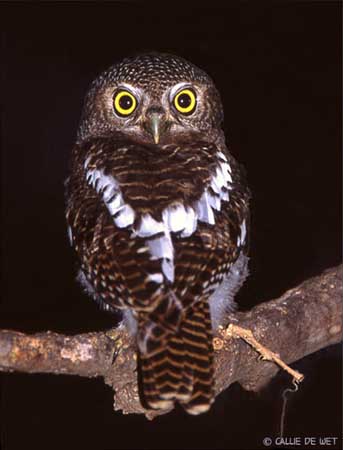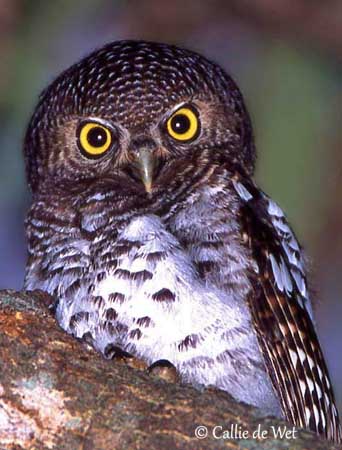
African Barred-Owl
Glaucidium capense
Strigiforme Order – Strigidae Family
BIOMETRICS:
Length : 20 à 21 cm
Wingspan : 40 cm
Weight : M : 83 à 132 g – F : 93 à 139 g
DESCRIPTION:
African barred-Owl is a small large-headed owl, but it lacks ear tufts and nape spots (“false eyes”).
We find some subspecies with different details in plumage, according to the region.
Glaucidium capense capense and Glaucidium capense ngamiense, from southern and central Africa, have grey-brown upperparts, finely barred with buff, and white eyebrow.
Glaucidium capense scheffleri and Glaucidium capense castaneum, from eastern Africa, have fine buff bars on head and nape, and often plain rufous plumage.
Glaucidium capense etchecopari, from western Africa, has deep rufous-brown and unbarred back.
In all species, face is generally finely barred. Scapulars and greater wing coverts have white outer webs with dark tips. Underparts show brown chest, finely barred with buff. Lower chest and flanks are white, spotted with dark brown feather tips. Underwing coverts, legs and vent are white, or sometimes with buff coverts. Flight and tail feathers are dark brown with fine rufous bars.
But colours and markings vary, according to individual and regional variations.
Head is large and rounded, without ear-tufts. Hooked bill and cere are greenish-yellow. Eyes are pale yellow. Feet are dull yellow to pale brown.
Both sexes are similar in plumage, but female is slightly larger than male.
Juvenile resembles adults, but its plumage is less marked overall. Young generally reach their sexual maturity at about one year of age.
FLIGHT:
African barred-Owl flies with audible, fast wing beats, alternating with short, dipping glides.
REPRODUCTION:
African barred-Owl nests in tree holes, in abandoned woodpecker hole, in natural cavity, or even sometimes in a nest-box.
During incubation, female rarely leaves the nest. Parents provide food to the young very soon after hatching. In the early stages, young are fed with insects, and later with small mammals.
DIET:
African barred-Owl feeds mainly on insects. During breeding season, it also consumes small mice and birds. As all other owls’ species, African barred-owl regurgitates pellets with indigestible parts such as feathers, claws, bones, teeth…
PROTECTION / THREATS / STATUS:
African barred-Owl is widespread in some parts of its range, but local and uncommon in other places. It is mainly found in wooded patches rather in more open areas.
Fr : Chevêchette du Cap
All : Kapkauz
Esp : Mochuelo de El Cabo
Ital : Civetta nana barrata africana
Nd : Kaapse Dwerguil
Photographs by Callie de Wet
GALLERY
Text by Nicole Bouglouan
Sources :
HANDBOOK OF THE BIRDS OF THE WORLD Vol 5 by Josep del Hoyo-Andrew Elliott-Jordi Sargatal - Lynx Edicions - ISBN: 8487334253
BIRDS OF AFRICA SOUTH OF THE SAHARA by Ian Sinclair and Peter Ryan - Princeton University Press Princeton and Oxford - ISBN: 0691118159
Owls and Owling in Southern Africa by Warwick Tarboton and Rudy Erasmus - Tracey Hawthorne - ISBN: 1868721043

VOICE: SOUNDS BY XENO-CANTO
African barred-Owl’s call is a series of several soft notes, increasing in volume “kerrr- kerrr- kerrr- kerrr”. These notes are often followed by purring whistles “trru- trrre, trru-trrre”, with the second note higher pitched and other series at one pitch “wirow wirow wirow wirow”. Calls are the same across the whole range.
HABITAT:
African barred-Owl is locally common in mature woodlands, thickets, forests and edges. It is local and uncommon in open savannahs or along rivers.
RANGE:
African barred-Owl is widespread in some parts of Southern Africa, and Congo-Uganda border. We can find six or seven isolated populations across the African continent, from Western Africa to Eastern Cape.
BEHAVIOUR:
African barred-Owl is often perched within dense cover, but sometimes it may emerge during the day, and sit in open place. It is partly diurnal.
It hunts from a perch, diving on prey such as insects or small mammals.
